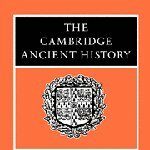
Ebook Info
- Published: 1992
- Number of pages: 962 pages
- Format: PDF
- File Size: 23.55 MB
- Authors: John Boardman
Description
During this period the dominant powers in the East were Assyria and then Babylonia. Each established an extensive empire that was based on Mesopotamia, and each in turn fell largely through internal strife.
User’s Reviews
Editorial Reviews: Review “The answer to the question whether the ancient world is worth studying is ‘yes’, and the Cambridge Ancient History proves it….CAH III/2 is an impressive achievement.” John Ray, Times Literary Supplement Book Description Volume III Part II describes the rise and fall of the great empires of Assyria and Babylonia, the sack of Jerusalem and the exile of the Jews in Babylon.
Reviews from Amazon users which were colected at the time this book was published on the website:
⭐The Cambridge Ancient History multivolume set is considered by many as the leading authority in the field. Compiled by a publisher with an eye to maintaining as accurate as possible glimpse back into the fog of the distant past. Utilizing leading scholars with an expertise pertaining to specific eras and regions, the series attempts to paint a full cultural picture of the leading societies of the “classic” regions of the Near East, North Africa, the Mediterranean Sea, and into northern Europe as the Roman Empire spread in that direction. Because of both the wide extent of royal record keeping and the corresponding lower availability of the archeological “accident of discovery”, records of many of the other sectors of a given society are smaller. During many eras military narrative predominates. This tends to be the case with this specific book (Vol.3, book 2- 2nd edition- printed 1991). Yet even here, a decent picture can be gathered of many aspects of life back in 750-500 BC. A separate book (Vol.3, book 3) covers much more extensively the cultural development of the young Greek society along with it’s contribution and influence on history, as it delves into the growth of Greek cities, art, philosophy, and commerce.This series does not cover central or eastern Asia, not to mention North or South America, nor much of rest of Africa.
⭐I own and have read almost this entire set of books. Yes the writing is a little wooden in places and no it does not read like and adventure store, but you can’t begin to explain what you believe if you don’t read and understand the Holy Bible and the history that reveals its truths.The multiple authors who were brought together to compose these books are not Bible believing Christians, that is perfectly clear when you read them, But, they just can’t help them selves as they expound on the history of the Middle East. Everything they present just proves more and more the truth of the Bible writers and the foreknowledge of the living God. No Christian should be without a set of theses books in his home and they should be well highlighted.
⭐Cambridge Ancient History is always dense with information. It is the best single book on a time period though does not include up-to-date information and takes a very conservative view always hedging on its dates. I wish that for a book as expensive as these are they would use better paper. This is the kind that ages very badly. For the most current information you will still have to go to a more specific book by a reliable source. I still recommend them. I have 6 of them now.
⭐I first made my acquaintance with the Cambridge Ancient History when I was in graduate school. Even though my studies were in the nineteenth century (British politics) I developed I real fascination for ancient history, and of course these volumes suggested themselves to me. They are, without question the standard, for a serious in-depth history of the ancient world. The only series that is remotely like the Cambridge Ancient History (CAH) is a current series put out by Routledge Publishers- the Routledge History of the Ancient World. That series, which is much newer than the CAH (Cambridge Ancient History) lacks also much of the in-depth area speciality of the Cambridge Ancient History, and does not include volumes on pre-history and on the early history of he earth and it’s geology which the CAH does in it’s first volume. The Routledge series began in the 1990’s and has just finished- it comprises about 8 volumes. (I should add that there are 2 editions of the CAH- both of value, but with different perspectives and updates to information and bibliographies. The first edition of the CAH began around 1925 and went to 12 volumes; the new edition has been coming out since the late 1980’s and includes two new volumes on the Late Empire and Late Antiquity. Both of these series are unique, and employ some of the best scholars now working in the fields of ancient history and archaeology. They are a remarkable achievement in historical scholarship. Updates are planned for all volumes as needed.The Cambridge Ancient History covers all aspects of world history in as much detail as is warranted by each author. It is designed as an in-depth work, focused on each area of the world it covers-Egypt, Anatolia, Syria, Babylonia and their political & social history and religious development. Special attention is given to archaeological sites and their remains and their interpretation for each culture. The series presumes extensive prior knowledge, and is written for specialists and researchers and as a sort of extensive literature review. The authors of each chapter (in both series) are the best scholars that are available in the field. Each volume alternates chapters between different areas and time periods, but each volume usually has some overall continuity. The second edition has some wonderful chapters by Peter Brown on early Christianity; the 4th volume of the 1st edition is on Eastern Roman Empire. Edited by J.B. Bury, the 4th volume of this 1st series is a classic. The first volume of each set (old and new edition) covers subjects such as the age of the earth and continents and how areas formed-essentially geological history- something completely different from the Routledge series and lots of fun. There is a tendency to treat the chapters in the CAH as sort of the last word- the authors would not agree. They are essentially the best that can be said on the subject at the time the volumes were published. As such, they will always need updating.Each volume is organized chronologically- and then by specialized subject areas. The volume under review is an update of the first edition of the CAH. It covers the Assyrian and Babylonian empires and assorted states and their development from the 8th to the 6th century B.C. This is an enormously important period of time, witnessing the emergence of distinct and vital cultures in the Middle East as well as the rise of the Assyrian and Babylonian empires. It is complex, and very hard to disentangle and make sense of-lack of evidence being one of the primary problems.The authors of each chapter do their best to make the history come alive and to make the evidence comprehensible. One of the great features of the CAH and their contributors is that do not tend to go beyond their evidence, and are as clear as they can be in their writings.Maps are included (pull-out maps that are really excellent) and an extensive bibliography on each area under discussion. The author of this volume, John Boardman is a specialist in Greek history and art and he edits this volume. I have collected all of the volumes and read most of them. You simply cannot find a better source for full-scale treatment of complex historical issues.
⭐The entire set of this spectacular series is wonderful. This particular volume covers an extremely important part of the ancient Mediterranean basin’s history, the eighth to the sixth centuries BCE. This time is vital to world history, because it resulted in the destruction of the Kingdom of Israel, and then Judah, ending in the famous “Babylonian Exile.” This exile in turn, is what led to the writing down of the Torah, and other parts of the Bible, due to the fear of their being lost in a foreign land. The Bible is one of the most influential books ever written, perhaps the most influential book ever written, and the events that resulted in it being written down, instead of being passed down orally, played a key role in the creation of the modern world. I own the entire set of these wonderful books, and it occupies a prominent place on my bookshelves.It is indeed a shame to see how expensive they have become. This set is the sine qua non of the serious ancient Mediterranean historian.
⭐
Keywords
Free Download The Cambridge Ancient History, Volume 3, Part 2: The Assyrian and Babylonian Empires and Other States of the Near East, from the Eighth to the Sixth Centuries BC in PDF format
The Cambridge Ancient History, Volume 3, Part 2: The Assyrian and Babylonian Empires and Other States of the Near East, from the Eighth to the Sixth Centuries BC PDF Free Download
Download The Cambridge Ancient History, Volume 3, Part 2: The Assyrian and Babylonian Empires and Other States of the Near East, from the Eighth to the Sixth Centuries BC 1992 PDF Free
The Cambridge Ancient History, Volume 3, Part 2: The Assyrian and Babylonian Empires and Other States of the Near East, from the Eighth to the Sixth Centuries BC 1992 PDF Free Download
Download The Cambridge Ancient History, Volume 3, Part 2: The Assyrian and Babylonian Empires and Other States of the Near East, from the Eighth to the Sixth Centuries BC PDF
Free Download Ebook The Cambridge Ancient History, Volume 3, Part 2: The Assyrian and Babylonian Empires and Other States of the Near East, from the Eighth to the Sixth Centuries BC





